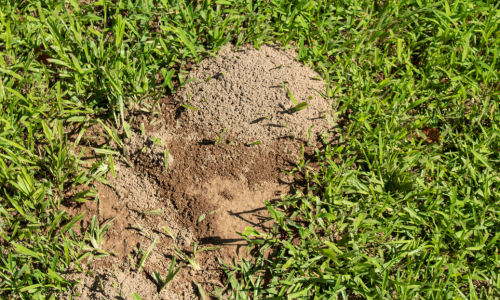A lush and well-maintained lawn is the pride of any homeowner, adding beauty and serenity to the outdoor space. However, hidden beneath the surface, an army of tiny intruders may be wreaking havoc on the health and aesthetics of your lawn. Ants, seemingly harmless creatures, can actually cause significant damage if left unchecked.
Our soil scientists will have written this blog to help you understand the damage unaddressed ant activity can have on your lawn, as well as provide effective preventive measures to preserve the splendor of your outdoor haven!
The Hidden Perils of Ant Activity

Ants are social insects with impressive organizational skills, often building vast underground colonies near or even beneath your lawn. While their industrious nature is admirable, their activity can lead to a range of issues that compromise the health and beauty of your turf. Here are some of the ways ants can harm your lawn:
- Undermining Soil Structure: Ant colonies create intricate networks of tunnels and chambers underground, causing soil erosion and destabilizing the ground beneath your lawn. This can result in uneven surfaces, sinkholes, and a weakened foundation for your grass, leading to unsightly bare patches.
- Damage to Grass Roots: Some ant species, such as the thatching ant, feed on grass roots, depriving the plants of essential nutrients and moisture. This weakens the grass, making it more susceptible to diseases, drought, and harsh weather conditions.
- Unsightly Mounds and Nests: Ants construct distinctive mounds on the surface, disrupting the aesthetics of your lawn. These mounds can also smother your grass, impede foot traffic, hinder children’s play, or even damage your lawn mower. Moreover, stepping on an ant mound may result in painful ant bites or stings, making your lawn less enjoyable and potentially unsafe.
- Aphid farming: Some ant species maintain a symbiotic relationship with aphids, which are small insects that feed on plant sap. Ants protect aphids from predators and parasites, while aphids produce a sweet substance called honeydew, which ants feed on. Unfortunately, aphids can cause damage to your lawn by sucking the sap from grass blades and other plants, leading to yellowing, stunted growth, and distortion.
Safeguarding the Health and Beauty of Your Lawn
Fortunately, there are simple, effective measures you can take to prevent ant activity from compromising the health and beauty of your lawn:
- Promote Healthy Soil: A well-nourished lawn is more resilient against ant infestations. Regularly test your soil’s pH levels and nutrient content to ensure optimal conditions for grass growth. Maintaining proper irrigation and mowing practices also contribute to a healthier lawn that is less vulnerable to ant damage.
- Remove Attractive Food Sources: Ants are attracted to sugary substances and food debris. Regularly clean up food, fallen fruit, and other potential food sources to discourage ants from venturing onto your lawn.
- Apply Ant Repellents: Consider using natural ant repellents or deterrents around your lawn’s perimeter to discourage ant colonies from establishing themselves. Substances like diatomaceous earth, coffee grounds, or essential oils like peppermint and citrus can help create a barrier that ants find unappealing.
- Professional Intervention: In cases of a severe ant infestation or persistent issues, seeking professional assistance from a lawn care company is highly recommended. Experienced professionals can identify the ant species, employ targeted treatments, and provide ongoing maintenance to safeguard your lawn’s health and appearance.
Don’t let ant activity sabotage the splendor or health of your lawn. By being proactive and implementing the preventive measures discussed above, you can fortify your green space against these tiny intruders.

Send the Ants Marching
Ant Control landing page
"*" indicates required fields
